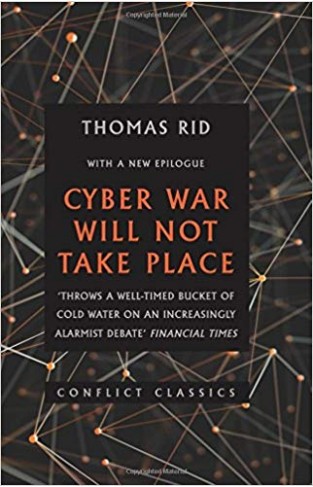Cyber War Will Not Take Place (Conflict Classics)
By: Thomas Rid
-
Rs 1,795.50
- Rs 1,995.00
- 10%
You save Rs 199.50.
Due to constant currency fluctuation, prices are subject to change with or without notice.
'Cyber war is coming,' announced a landmark RAND report in 1993. In 2005, the U.S. Air Force boasted it would now fly, fight, and win in cyberspace, the 'fifth domain' of warfare. This book takes stock, twenty years on: is cyber war really coming? Has war indeed entered the fifth domain?Cyber War Will Not Take Place cuts through the hype and takes a fresh look at cyber security. Thomas Rid argues that the focus on war and winning distracts from the real challenge of cyberspace: non-violent confrontation that may rival or even replace violence in surprising ways.The threat consists of three different vectors: espionage, sabotage, and subversion. The author traces the most significant hacks and attacks, exploring the full spectrum of case studies from the shadowy world of computer espionage and weaponised code. With a mix of technical detail and rigorous political analysis, the book explores some key questions: What are cyber weapons? How have they changed the meaning of violence? How likely and how dangerous is crowd-sourced subversive activity? Why has there never been a lethal cyber attack against a country's critical infrastructure?How serious is the threat of 'pure' cyber espionage, of exfiltrating data without infiltrating humans first? And who is most vulnerable: which countries, industries, individuals?
'Cyber war is coming,' announced a landmark RAND report in 1993. In 2005, the U.S. Air Force boasted it would now fly, fight, and win in cyberspace, the 'fifth domain' of warfare. This book takes stock, twenty years on: is cyber war really coming? Has war indeed entered the fifth domain?Cyber War Will Not Take Place cuts through the hype and takes a fresh look at cyber security. Thomas Rid argues that the focus on war and winning distracts from the real challenge of cyberspace: non-violent confrontation that may rival or even replace violence in surprising ways.The threat consists of three different vectors: espionage, sabotage, and subversion. The author traces the most significant hacks and attacks, exploring the full spectrum of case studies from the shadowy world of computer espionage and weaponised code. With a mix of technical detail and rigorous political analysis, the book explores some key questions: What are cyber weapons? How have they changed the meaning of violence? How likely and how dangerous is crowd-sourced subversive activity? Why has there never been a lethal cyber attack against a country's critical infrastructure?How serious is the threat of 'pure' cyber espionage, of exfiltrating data without infiltrating humans first? And who is most vulnerable: which countries, industries, individuals?
Cyber War Will Not Take Place (Conflict Classics)
By: Thomas Rid
Rs 1,795.50 Rs 1,995.00 Ex Tax :Rs 1,795.50
Zubin Mehta: A Musical Journey (An Authorized Biography)
By: VOID - Bakhtiar K. Dadabhoy
Rs 472.50 Rs 1,050.00 Ex Tax :Rs 472.50
Britains National Security Challenges Extremism Cyber Terrorism Sectarianism and Takfiri
By: Musa Khan Jalalzai
Rs 712.25 Rs 1,295.00 Ex Tax :Rs 712.25
Artificial Intelligence (WIRED guides): How Machine Learning Will Shape the Next
By: Matthew Burgess
Rs 2,245.50 Rs 2,495.00 Ex Tax :Rs 2,245.50
Artificial Intelligence: Modern Magic or Dangerous Future? (Hot Science)
By: Yorick Wilks
Rs 2,065.50 Rs 2,295.00 Ex Tax :Rs 2,065.50
Will Artificial Intelligence Outsmart Us?
By: Stephen Hawking
Rs 1,255.50 Rs 1,395.00 Ex Tax :Rs 1,255.50
Manning Up: How the Rise of Women Has Turned Men into Boys
By: Kay Hymowitz
Rs 646.75 Rs 995.00 Ex Tax :Rs 646.75
Britains National Security Challenges Extremism Cyber Terrorism Sectarianism and Takfiri
By: Musa Khan Jalalzai
Rs 712.25 Rs 1,295.00 Ex Tax :Rs 712.25
Artificial Intelligence (WIRED guides): How Machine Learning Will Shape the Next
By: Matthew Burgess
Rs 2,245.50 Rs 2,495.00 Ex Tax :Rs 2,245.50
Artificial Intelligence: Modern Magic or Dangerous Future? (Hot Science)
By: Yorick Wilks
Rs 2,065.50 Rs 2,295.00 Ex Tax :Rs 2,065.50
Will Artificial Intelligence Outsmart Us?
By: Stephen Hawking
Rs 1,255.50 Rs 1,395.00 Ex Tax :Rs 1,255.50
No recently viewed books available at the moment.
Zubin Mehta: A Musical Journey (An Authorized Biography)
By: VOID - Bakhtiar K. Dadabhoy
Rs 472.50 Rs 1,050.00 Ex Tax :Rs 472.50
Cyber War Will Not Take Place (Conflict Classics)
By: Thomas Rid
Rs 1,795.50 Rs 1,995.00 Ex Tax :Rs 1,795.50
Britains National Security Challenges Extremism Cyber Terrorism Sectarianism and Takfiri
By: Musa Khan Jalalzai
Rs 712.25 Rs 1,295.00 Ex Tax :Rs 712.25
Artificial Intelligence (WIRED guides): How Machine Learning Will Shape the Next
By: Matthew Burgess
Rs 2,245.50 Rs 2,495.00 Ex Tax :Rs 2,245.50
Artificial Intelligence: Modern Magic or Dangerous Future? (Hot Science)
By: Yorick Wilks
Rs 2,065.50 Rs 2,295.00 Ex Tax :Rs 2,065.50
Will Artificial Intelligence Outsmart Us?
By: Stephen Hawking
Rs 1,255.50 Rs 1,395.00 Ex Tax :Rs 1,255.50













-120x187.jpg?q6)

















